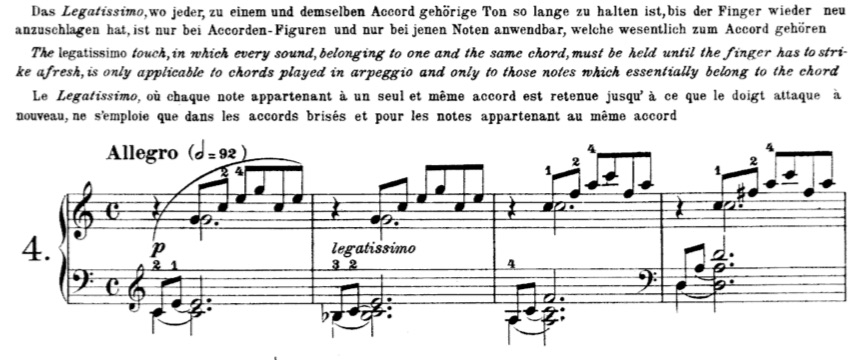The Simplified French Style
Czerny is the only source found so far that shows the long note at the start of an arpeggiated chord to indicate the use of the prolonged touch. He shows this as an alternative notation compared to the French style. Despite this notation appearing second, it is actually the notation that he uses most to ask for the prolonged touch, both in his Op. 500 treatise and in other works examined. This may be just short-hand for the French style that uses only a long note to bind the chord tones together rather than with ties. The long note can also be thought of as the beginning and end of a slur which is another way of notating the prolonged touch. Interestingly, the German edition of this work also has a slur over the second part of the example.
Figure 2.9. Czerny’s prolonged touch1
This notation appears in strong connection with Legatissimo and Molto Legato in Czerny’s didactic works, including Op. 500. As previously stated, Legatissimo and Molto Legato are defined as “very connected; nearly approaching to the prolonged touch” by Czerny.2 While it is not identical in this definition, an earlier definition by Czerny matches older definitions of the prolonged touch perfectly. In Op. 335, “School of Legato and Staccato,” Czerny describes many different types of touch. The prolonged touch term is not used but legatissimo is. Czerny states at the beginning of etude number four: “The legatissimo touch, in which every sound beginning to one and the same chord, must be held until the finger has to strike afresh, is only applicable to chords played in arpeggio and only to those notes which essentially belong to the chord.”3 This etude then summarizes all of the types of notation that have been given so far and uses the work legatissimo in the score. It demonstrates a cleaner French style in many places. The slur is present on the right hand part in many places that are not phrasing markings. And the long initial not is present throughout the etude and is the most prevalent of the three notations.
Figure 2.10. Czerny Op. 335, no. 4, mm. 1-44
Interestingly, Brahms uses this type of notation in one of his songs from Op. 72 (ca. 1877). To make clear to any pianist what is desired, he first uses the French notation to show the prolonged touch. But after two bars of this pattern, Brahms changes it to the simplified version of the notation with a long, initial bass note, a slur, and the instructions of simile legato.


